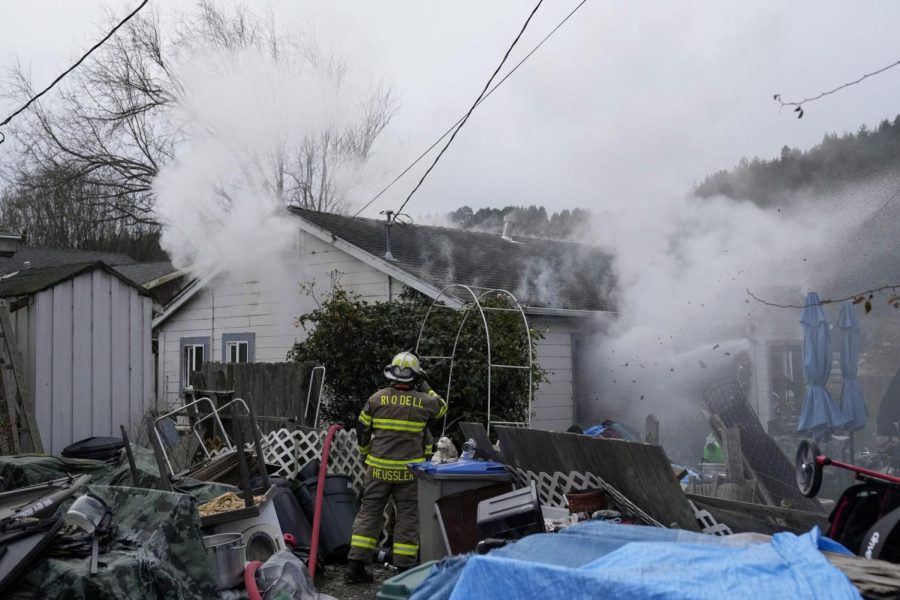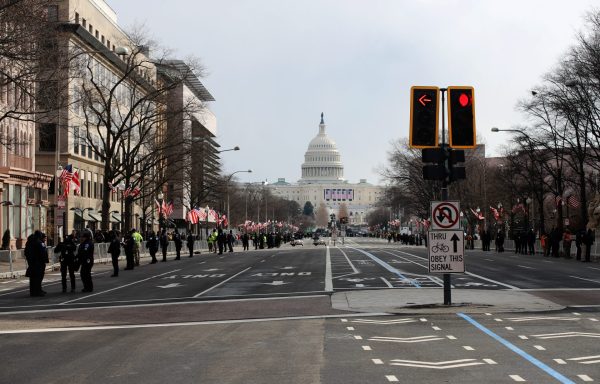Weeks of extreme weather and disaster leave citizens uncertain about the future of California’s climate
Godofredo A. Vásquez | AP for The DePaulia
Firefighters battle a residence fire in Rio Dell, Calif., Wednesday, Dec. 21, 2022.
Uprooted trees, dark buildings and streets filled with brown, murky water have become a daily occurrence for Californians. A combination of earthquakes, cyclones and storms over the past few weeks have negatively impacted many, but the forecast shows that this extreme weather is far from over.
After a devastating magnitude 6.4 earthquake in Northern California on Dec. 20, the state then faced a series of snow storms and rainstorms with strong winds over Christmas weekend in Southern California, with some areas even facing whiteout conditions. The weather eased up until New Year’s weekend, when Southern California was hit with another series of harsh storms and Northern California was hit by a 5.4 magnitude earthquake resulting in power outages in the area.
“When you have an earthquake as big as a 6.4, it is a common occurrence that it is followed by a smaller aftershock later, like in this case in California,” University of Chicago seismology professor Sun Young Park said. “There is also a tidal effect when earthquakes happen, both cause and effect between the two. When it comes to extreme weather, earthquakes aren’t closely related to what happens in the climate. However, there is research showing that we are getting higher frequencies of extreme weather due to climate change.”
Despite heavy snow, rainstorms and high tides, California just last year suffered their worst drought in over 100 years. According to the National Integrated Drought Information System, most of California’s soil is abnormally dry and 80.6% of California falls under the category of a severe drought, which will promote a longer fire season and a decrease in wildlife.
“I was visiting Los Angeles for the first time with my family after Christmas wanting to escape the cold Minnesota winter,” Los Angeles tourist Kieran Aus said. “All I usually hear about [California] is their sunny weather, but when I got there it was gloomy and raining quite a bit. My flight home was actually delayed a while. I was surprised to see California like this after hearing so much about a drought, but a couple days ago it seemed like the opposite of that.”
However, California is expected to continue to see stronger and more persistent storms in the upcoming week.
According to the National Weather Service, from Jan. 4 to Jan. 10, California will be facing a winter storm warning with one to three feet of snowfall and winds gusting as high as 55 mph. Western Plumas County is expected to be hit the most because of its high elevation. The NWS also issued a high surf advisory and flood watch everywhere else in the state, factored from the excess water already present and expected snowfall.
The Bay Area is also going to be heavily affected by the upcoming winter storm warning due to being hit by record-breaking rainfall, which will make the high surf and flood even worse.
“The wettest 10 day period for Downtown San Francisco since 1871! Downtown San Francisco received 10.33″ Dec 26 – Jan 4 (yesterday). All time 10 day record was 14.37″ in January 1862,” the NWS Bay Area Twitter account tweeted on Jan. 5.
Further into the month, California is expected to see consistent rainfall throughout the month of January.
“I’m from the Bay Area and the weather there was simply terrible when I was back for break, not like what it usually is,” DePaul freshman Rhythm Cannon said. “Just gray skies and a lot of rain and water everywhere. I know there were power outages in the area, luckily mine didn’t go out. Honestly, I was excited to get back to Chicago for school because of the weather, I didn’t want to have to deal with those bad storms anymore.”







